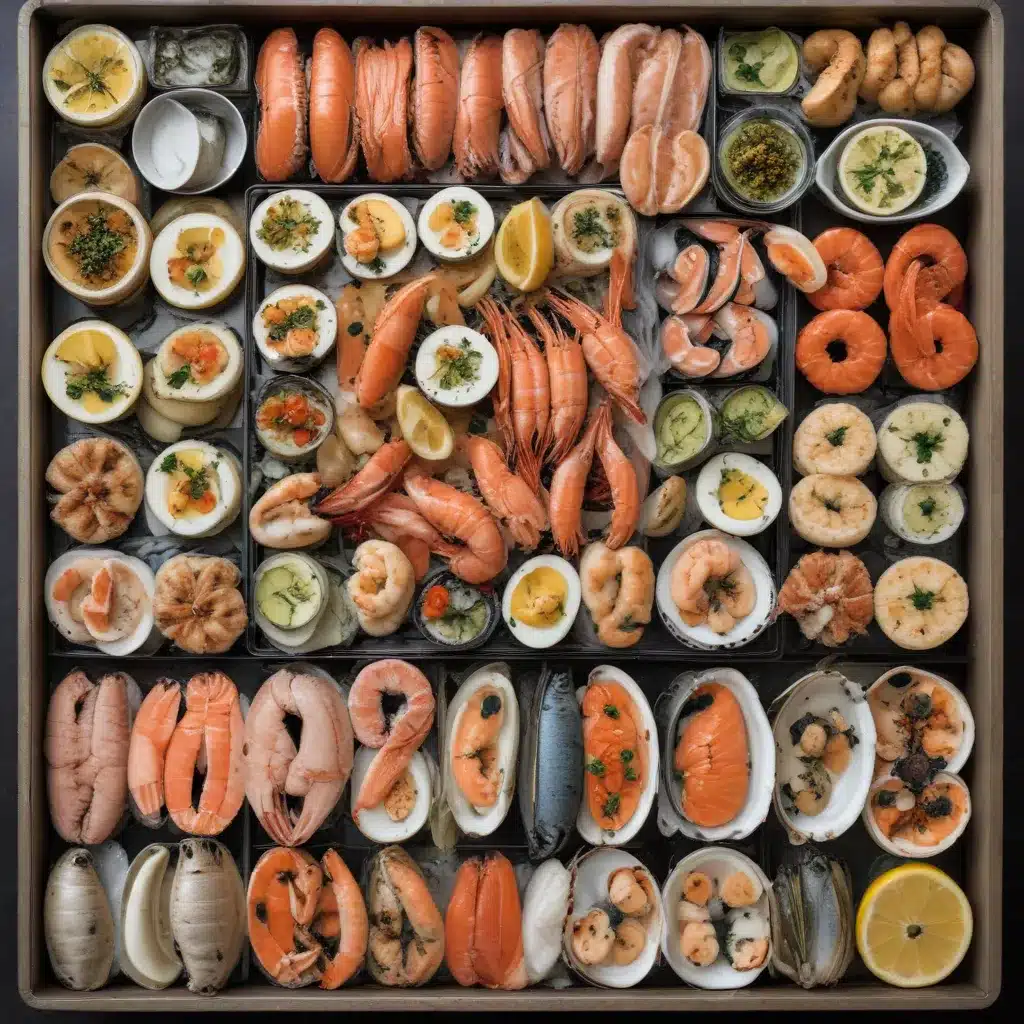
As a seafood dining expert writing for Fish Tales Cafe, I’m thrilled to share invaluable insights on elevating your culinary experiences through proper seafood storage techniques. Whether you’re a seasoned chef or a passionate home cook, mastering the art of seafood preservation is the key to unlocking the full potential of your seafood dishes.
Seafood Freshness Criteria
The foundation of any remarkable seafood dish starts with fresh, high-quality ingredients. When it comes to seafood, freshness is paramount, as it directly influences the flavor, texture, and overall dining experience. To ensure you’re working with the best possible products, familiarize yourself with the telltale signs of freshness:
- Cod: A firm, resilient texture, bright and clear eyes, and a fresh, briny aroma. Avoid any discoloration or signs of drying.
- Shrimp: Tightly curled bodies, firm and crisp shells, and a sweet, ocean-kissed scent. Steer clear of any discoloration or strong, unpleasant odors.
- Scallops: Plump, glossy white or pinkish-orange appearance, and a delicate, slightly sweet fragrance. Reject any scallops that appear dry, shriveled, or have a strong, fishy smell.
Mastering these indicators will empower you to make informed purchasing decisions, leading to consistently remarkable seafood dishes.
Proper Refrigeration Techniques
Once you’ve secured the freshest seafood, proper storage becomes crucial. Refrigeration is the primary means of preserving seafood’s delicate properties, and understanding the nuances can make all the difference.
For cod, keep it stored at temperatures between 32°F and 40°F (0°C to 4°C). Wrap the fillets in plastic or parchment paper to prevent dehydration, and consume within 2-3 days for optimal freshness.
When it comes to shrimp, store them in the coldest part of your refrigerator, ideally at 32°F (0°C) or below. Tightly wrap the shrimp in a moisture-resistant package, and use them within 2-3 days for the best texture and flavor.
Scallops require even more precise temperature control, thriving at 32°F (0°C) or slightly below. Arrange them in a single layer on a bed of ice, and consume within 2 days for the most delectable results.
Freezing and Thawing Guidelines
While refrigeration is excellent for short-term storage, freezing is the go-to method for preserving seafood for extended periods. When done correctly, this technique can remarkably maintain the integrity of your seafood.
For cod, wrap the fillets tightly in plastic or foil, removing as much air as possible, and store them at 0°F (-18°C) or below. Frozen cod can retain its quality for 6-8 months. When ready to use, thaw the fillets in the refrigerator for 12-24 hours, ensuring a gradual and even temperature transition.
Shrimp also freeze exceptionally well. Peel, devein, and arrange the shrimp in a single layer on a baking sheet before transferring them to an airtight container or bag. Frozen shrimp will stay fresh for 9-12 months. To thaw, place the shrimp in the refrigerator for 12-18 hours, or use the cold-water method, which takes 30 minutes to an hour.
Scallops, with their delicate nature, require extra care when freezing. Gently pat them dry, arrange in a single layer, and freeze. Stored at 0°F (-18°C) or below, frozen scallops can maintain their quality for 3-6 months. Thaw them in the refrigerator for 12-24 hours before use.
Seafood Handling Protocols
Proper handling techniques are equally vital to preserving seafood’s integrity. From cleaning and preparation to temperature control, adhering to best practices will ensure your seafood remains in optimal condition.
Cleaning and Preparation Methods
Start by thoroughly rinsing your seafood under cold running water, removing any dirt, debris, or impurities. For cod, gently pat the fillets dry with paper towels before storing. For shrimp and scallops, carefully peel, devein, and pat dry.
Temperature Control Considerations
Maintain a constant temperature throughout the handling process. Avoid leaving seafood at room temperature for extended periods, as this can quickly compromise its freshness.
Shelf Life Maximization Strategies
Learn to recognize the signs of spoilage, such as discoloration, off-odors, or sliminess, and discard any seafood that has passed its prime. Proper handling and storage will help you maximize the shelf life of your seafood.
Seafood Quality Preservation
Ensuring the long-term quality of your seafood requires attention to packaging, transportation, and inventory management.
Packaging and Labeling Essentials
Invest in high-quality, airtight containers or vacuum-sealed bags to prevent freezer burn and dehydration. Clearly label each package with the seafood type, date, and any other relevant information.
Transportation and Distribution Factors
When sourcing seafood, work with reputable suppliers who maintain strict temperature controls during transportation and distribution. Inquire about their handling protocols to ensure the seafood arrives at your doorstep in pristine condition.
Inventory Management Optimization
Practice a “first in, first out” approach to your seafood inventory, ensuring the oldest items are used first. Regularly rotate your stock and discard any seafood that has reached the end of its shelf life.
Culinary Applications of Stored Seafood
With a solid understanding of seafood storage and handling, you can confidently incorporate these well-preserved ingredients into a wide range of culinary creations.
Flavor Profile Enhancements
Properly stored seafood will retain its natural, vibrant flavors, allowing you to showcase them in dishes like pan-seared cod with lemon-caper butter or herb-crusted scallops.
Texture and Appearance Preservation
Preserving the seafood’s texture and appearance is crucial for visually stunning presentations. Enjoy the firm, flaky texture of baked cod en papillote or the succulent bite of grilled shrimp skewers.
Dish Preparation Adjustments
Adjust your cooking methods and timing to account for the quality and handling of your stored seafood. For example, quickly searing frozen scallops will yield a tender, caramelized exterior without overcooking the interior.
By mastering the art of seafood storage and handling, you’ll be able to consistently deliver exceptional seafood dishes that elevate the dining experience. So, the next time you fire up the stove or preheat the oven, rest assured that your seafood ingredients are at their peak, ready to transform your culinary creations into culinary masterpieces. Visit https://www.fishtalescafe.com to discover more inspiring seafood recipes and expert tips.

